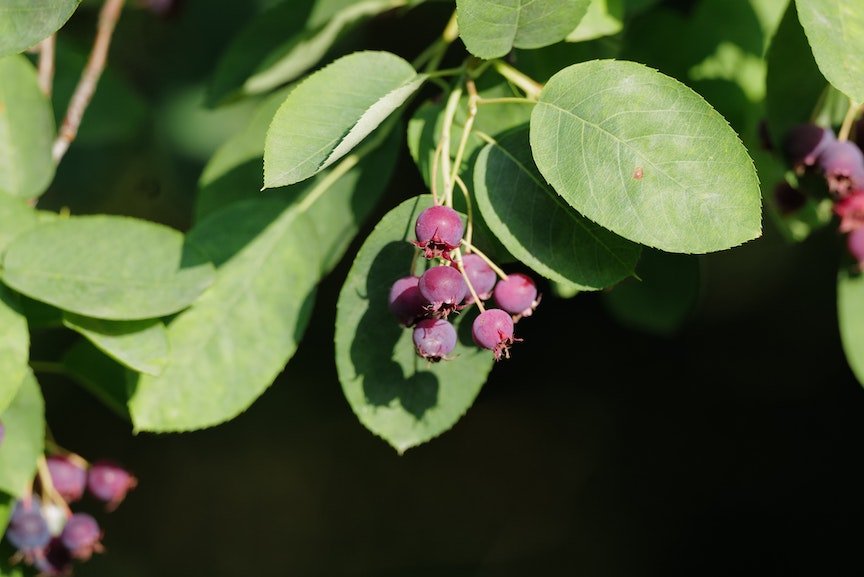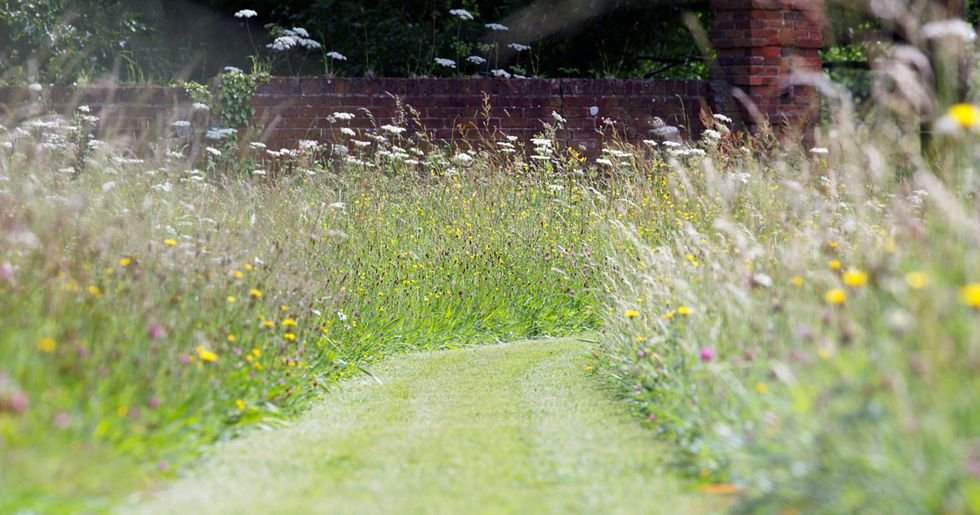… it seems a little incongruous to be celebrating winter gardens but if you like the images I included below, you will see why it got my attention. And winter, in my experience, always comes round again. You cannot buy Clare’s and Andrew’s book at the moment…
…but because you will probably want to, here is a link to Clare’s web site, Bud to Seed and you can sign up for her newsletter and get word of when it will be available.
Plant of the Week
Amerlanchier berries. Photo by Gearg Eiermann.
The Amelanchier canadensis has more common names than I have poorly labled pots of seeds coming along (or are those just weeds that I am nurturing? The use of compost as potting soil makes things a bit unclear) and many of them refer to the time of year when it blooms, which is also when the shad are running to spawn. It is the very first tree I added to my garden here in Virginia, and I love its spring flowers, edible fruits, and airy figuration.
The flowers on my Amelanchier faded just recently and you can see the blueberry-like fruits that are starting to form.
Besides the virtue of having of three season interest, with dainty white flowers in spring, edible berries that follow the flowers, and amazing fall color, the Amelanchier is native to the Eastern US and Canada. It’s a small tree, and because of its multiple trunks you may even call it a stretched out shrub. I feel it should be in every garden.
Chat with Clare Foster
After Clare and I sorted out some details of her ‘Winter Gardens’ book, we had to sort out the other ones!
We just touched on her book on Compost, because that topic has the ability to hijack a conversation if you get two enthusiasts going. My takeaway from that brief encounter is that I will have to have Clare back on the show for further exploration.
We got stuck into her book called ‘The Flower Garden: How to Grow Flowers from Seeds’. Books are linked here to my Amazon Store Front. Disclosure: you will be supporting Into the Garden with Leslie, very subtly, if you buy things there.
I am spending much more time and energy (but not $$) on bringing flowers from seeds this year, and Clare was very encouraging about it!
Clare mentioned some very unique gardening tools that are her go-to helpers in the garden. One was a contraption that she likened to sheep shears, and I think we will let that situation remain a mystery, but more clear is her preference for the Sneeboer hand fork. Which exact hand fork also has a shroud of uncertainty surrounding it, but the link is to some likely suspects, and they look like great tools.
Clare’s book on compost. A subject for another episode.
Coffee Time!
Please consider supporting Into the Garden with Leslie By buying me a cup of coffee
OR! Becoming a member of I’m into the Garden too!
I will send you some LH Gardens gear if you become a member
Garden Questions Answered,
Or at least opined upon…
To mulch around trees or not?
What is the best time to plants shrubs and perennials?
What is No Mow May?
Tips on moving houseplants outside for summer
Yes! See the flare?
To mulch around trees or not?
No No No. I said on the pod I was looking at 12-14'“ but honestly, this could be 20”.
The quick answer to this is yes. Mulch is good for plants in general, and in nature, trees supply their own mulch with falling leaves. If you aesthetic has you opting for the neat look of double shredded hardwood, that’s fine, but in the case of any mulch, it should not be piled up on the trunk of the tree. The natural flare of the the bottom of a tree’s trunk should always be exposed, or else bark will rot and the tree’s life will be shortened.
I have heard people call the situation of mulch piled up around the base of a tree a ‘mulch volcano’. I feel like mulch mountain might better describe the situation.
What is the best time to plants shrubs and perennials?
Where I live in central Virginia, the range is huge. Our soil doesn’t often freeze, and although plants will stress less if temperatures are consistently in the 40-70 range, you can take chances in the 30’s and just be ready to water heavily in the 80’s. The same approximate guidelines would apply to planting trees.
What is No Mow May?
This is what No Mow May could look like, according to PlantLIfe.org/UK
Is it a miracle meadow?
According to BeeCityUSA.org, this is a movement that started in England but some communities in Wisconsin have taken it on, and according to the New York Times, the idea is spreading in the midwest. The idea is to not mow your lawn, presumably for the 4 weeks of May, so that flowers will proliferate and bees will revel in the bucolic results.
I love the sound of No Mow May, and little do I know of lawn turf management, but I am pretty sure that e the most conspicuous consequence of not mowing your lawn for for 30 days is going to be exceedingly long grass.
If you have plenty of weeds growing in your lawn, they surely will burst forth with flowers (and then seeds!) so bees would probably like that a lot! But I wonder if flowers can readily materialize in an established lawn…
Which is why I am putting No Mow May to the test in my own back yard! I have set aside a little patch, about 3’ x 6’, and I actually stopped mowing in the first week of April!
A grand experiment, to be sure. I will keep you posted.
Tips on moving houseplants outside for summer (once, without to-ing and fro-ing).
Note: I am not a house plant expert, but this system works for me.
Look at the long range forecast! No heavy frosts to be seen, please but high 30’s should be okay.
Find a nice cool morning that will be followed by a warm day and warm following night.
Move them out in the morning, so they have a short, rude jolt of cold, but can quickly recover.
Put them in the shade, even if they love sun. They need a bit of acclimation, people.
Choose a sheltered space and group them together. If the forecast says 30, maybe your plants are in a 40 degree spot, like right against your house.
If the frost threatens, get ready to through sheets and towels over them.
As the spring weeks roll out, you can gather confidence about putting them where you want them for the rest of the season.
Next week…
Next week’s guest: Page Dickey.













